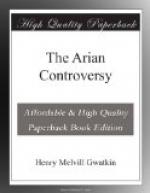Such seems to have been the plan laid down by the man who was now succeeding Athanasius as leader of the Nicene party. Basil of Caesarea was a disciple of the schools of Athens, and a master of heathen eloquence and learning. He was also man of the world enough to keep on friendly terms with men of all sorts. Amongst his friends we find Athanasius and Gregory of Nazianzus, Libanius the heathen rhetorician, the barbarian generals Arinthaeus and Victor, the renegade Modestus, and the Arian bishop Euippius. He was a Christian also of a Christian family. His grandmother, Macrina, was one of those who fled to the woods in the time of Diocletian’s persecution; and in after years young Basil learned from her the words of Gregory the Wonder worker. The connections of his early life were with the conservatives. He owed his baptism to Dianius of Caesarea, and much encouragement in asceticism to Eustathius of Sebastia. In 359 he accompanied Basil of Ancyra from Seleucia to the conferences at Constantinople, and on his return home came forward as a resolute enemy of Arianism at Caesarea. The young deacon was soon recognised as a power in Asia. He received the dying recantation of Dianius, and guided the choice of his successor Eusebius in 362. Yet he still acted with the Semiarians, and helped them with his counsel at Lampsacus. Indeed it was from the Semiarian side that he approached the Nicene faith. In his own city of Caesarea Eusebius found him indispensable. When jealousies arose between them, and Basil withdrew to his rustic paradise in Pontus, he was recalled by the clamour of the people at the approach of Valens in 365. This time the danger was averted by the Procopian troubles, but henceforth Basil governed Eusebius, and the church of Caesarea through him, till in the summer of 370 he succeeded to the bishopric himself.
[Sidenote: Basil bishop of Caesarea.]
The election was a critical one, for every one knew that a bishop like Basil would be a pillar of the Nicene cause. On one side were the officials and the lukewarm bishops, on the other the people and the better class of Semiarians. They had to make great efforts. Eusebius of Samosata came to Caesarea to urge the wavering bishops, and old Gregory[15] was carried from Nazianzus on his litter to perform the consecration. There was none but Basil who could meet the coming danger. By the spring of 371 Valens had fairly started on his progress to the East. He travelled slowly through the famine-wasted provinces, and only reached Caesarea in time for the great winter festival of Epiphany 372. The Nicene faith in Cappadocia was not the least of the abuses he was putting down. The bishops yielded in all directions, but Basil was unshaken. The rough threats of Modestus succeeded no better than the fatherly counsel of Euippius; and when Valens himself and Basil met face to face, the Emperor was overawed. More than once the order was prepared for the obstinate prelate’s exile, but for one reason or another it was never issued. Valens went forward on his journey, leaving behind a princely gift for Basil’s poorhouse. He reached Antioch in April, and settled there for the rest of his reign, never again leaving Syria till the disasters of the Gothic war called him back to Europe.




